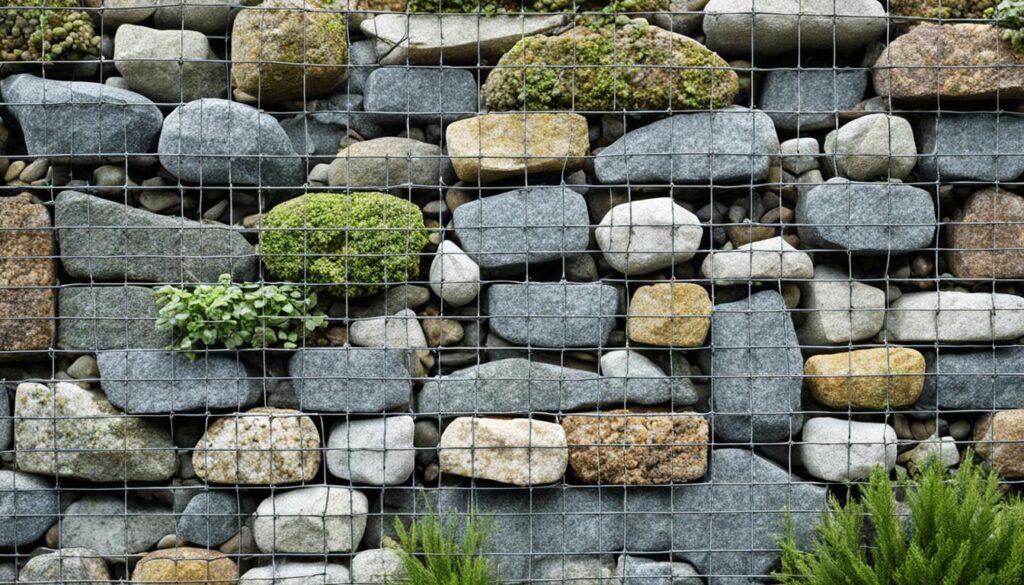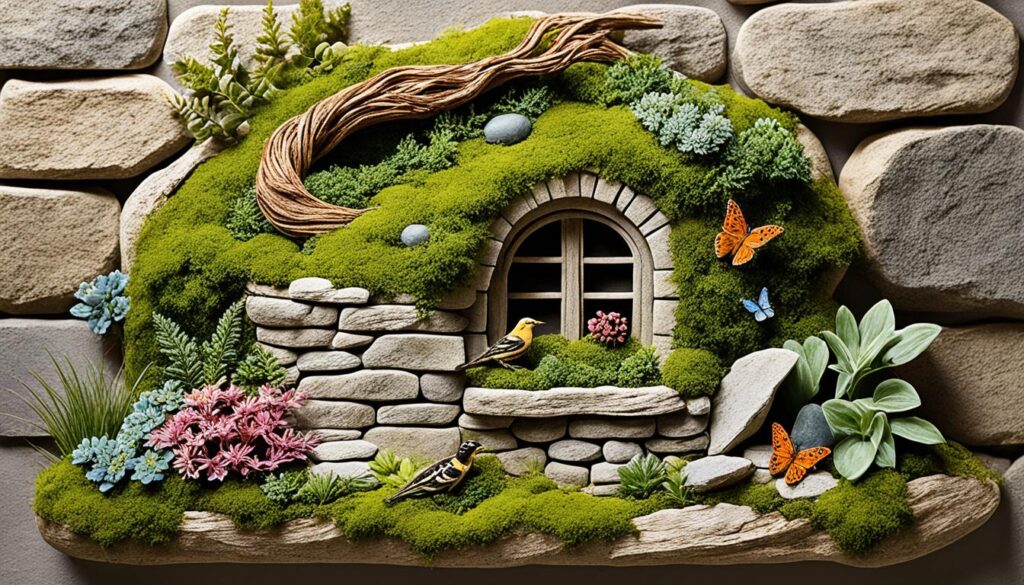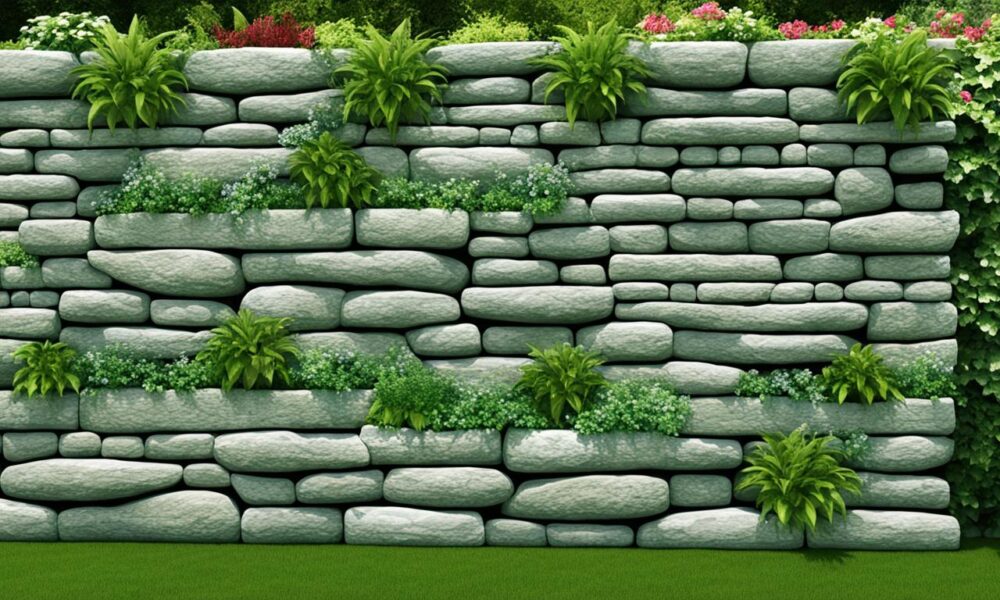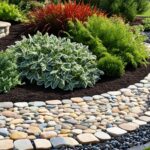Inspiring Natural Stone Garden Wall Ideas
Stone garden walls can transform outdoor spaces with their natural charm and longevity. They can serve various purposes, such as creating a feature wall, adding rustic appeal, retaining slopes, and providing privacy. When designing a stone garden wall, consider the specific needs of your space, whether it’s for aesthetic purposes or structural support. There are many materials and styles to choose from, including real or composite stone cladding, local dry-stone walling, and processed blocks. Careful assessment of weight-bearing and permeable materials is crucial for retaining walls. Here are 15 clever stone garden wall ideas to inspire your outdoor space.
Key Takeaways:
- Stone garden walls can enhance the aesthetics and functionality of outdoor spaces.
- Consider the specific needs of your space when choosing materials and styles for your stone garden wall.
- Weight-bearing and permeable materials are important factors to consider for retaining walls.
- There are various design options available, including curved walls, stone-filled gabions, and water feature walls.
- Planting ferns and native plants can add beauty and biodiversity to your stone garden wall.
Build in Some Curves
Curved stone walls can add a sense of movement and elegance to your garden. They create fluid lines that draw the eye and add visual interest to the space. When it comes to curved garden walls, Purbeck stone is an excellent choice. This type of stone naturally interlocks without the need for mortar, allowing you to create elegant and sinuous shapes.
To enhance the beauty of your curved stone wall, consider using similar materials and colors for your garden paths and paving. This cohesive design approach will highlight the textures and beauty of the stone, creating a harmonious outdoor space. You can also combine mellow stone cladding with rich timber to create a warm and welcoming outdoor entertaining area.
If you have a small patio, incorporating seating into the garden wall can be a smart space-saving solution. It not only adds functionality but also enhances the sense of openness and spaciousness in the area. Imagine enjoying a cup of coffee or a glass of wine while sitting on your beautifully curved stone wall.
Create a Welcoming Outdoor Entertaining Area
One way to make your stone wall more inviting is by incorporating seating. Building seating into the wall itself saves space and creates a seamless and integrated design. Choose comfortable cushions or pillows to make the seating area cozy and inviting.
Highlight the Fluid Lines with Complementary Plants
In addition to the curved stone wall, you can further enhance its beauty by selecting plants that complement its shape and color. Consider planting flowers or shrubs with soft and flowing forms. They will echo the fluid lines of the wall and create a harmonious and visually appealing composition.
| Plants for Curved Stone Walls | Description |
|---|---|
| Fountain Grass (Pennisetum orientale) | This ornamental grass features gracefully arching foliage and fluffy flowers that add movement to the garden. |
| Lady’s Mantle (Alchemilla mollis) | The soft, scalloped leaves of this perennial plant beautifully complement the organic lines of the curved stone wall. |
| Hydrangeas (Hydrangea spp.) | The large, showy blooms of hydrangeas provide a beautiful contrast to the rugged texture of the stone wall. |
Echo the Color of Stone in Your Planting
Enhance the beauty of your stone garden wall by choosing plants that complement its color and texture. Light and airy plant shapes like fennel, verbena bonariensis, and alliums can beautifully contrast with the textured stone. Standard trees with smooth silvery bark, such as beech and birch, add a statuesque feel to the space. Foliage, such as bronze and burgundy heucheras, creates continuity and blends the boundaries of the wall with the garden design. Ornamental grasses like carex and miscanthus sinensis add texture and graceful movement against the rugged stone.
| Plant Name | Description |
|---|---|
| Fennel | Light and airy plant with feathery foliage that contrasts with the textured stone. |
| Verbena Bonariensis | Delicate plant with clusters of small purple flowers that stand out against the stone. |
| Alliums | Tall and striking flowers in various colors, adding vertical interest to the stone wall. |
| Beech | Tree with smooth silvery bark that adds a statuesque feel to the garden wall. |
| Birch | Tree known for its slender trunk and silvery bark, providing an elegant touch to the space. |
| Heucheras | Foliage plants in bronze and burgundy shades that create continuity and blend with the stone wall. |
| Carex | Ornamental grass with spiky foliage that adds texture and movement against the rugged stone. |
| Miscanthus Sinensis | Tall, graceful grass with feathery plumes that create a soft and elegant contrast to the stone wall. |
“The beauty of a stone garden wall can be elevated by selecting the right plants that complement its color and texture.”
Show off Stone in All Its Glory
When it comes to stone garden walls, showcasing the natural beauty of the stone is key. By utilizing different forms and finishes of the stone, you can create a visually stunning and captivating design. Consider incorporating smooth, honed, and sawn-edged slabs, as well as gabions filled with freshly quarried rock, to introduce contrasting textures and tones to your garden.
One creative way to showcase stone walls is by using neatly filled gabions in an “L” shape. This design not only adds sculptural and textured visual interest to your front garden but also guides visitors to the front door, making a lasting impression.
By highlighting the unique characteristics of stone, you can create a stunning contemporary look or evoke a rustic vibe in your outdoor space.
Stone Wall Design Inspiration
| Stone Type | Finish | Application |
|---|---|---|
| Natural sandstone | Smooth | Feature wall surrounding a patio |
| Granite | Honed | Retaining wall for a raised flower bed |
| Limestone | Sawn-edged | Water feature wall with cascading waterfalls |
Plant Up a Stone Wall with Native Ferns
Planting ferns in the cracks and crevices of a stone wall can create a naturalistic and visually appealing feature. Stone garden walls that have been there for generations quickly become home to insects, mammals, and birds, fostering biodiversity and supporting pollinators. Using a semi-dry wall technique with reclaimed stone from an old farmyard can provide a low-maintenance and sustainable wildlife garden. Consider growing ferns in your stone wall to add a touch of greenery and enhance the natural beauty of your outdoor space.
When it comes to choosing ferns for your stone wall, opt for native varieties that will thrive in your local climate. Native ferns are well-adapted to the conditions and will establish themselves easily on the wall. They also provide habitat and food for local wildlife, contributing to a healthy ecosystem.
Here are some popular ferns that are perfect for planting in stone walls:
- Athyrium filix-femina (Lady Fern) – With graceful fronds and a delicate appearance, this fern adds a touch of elegance to any stone wall.
- Polystichum acrostichoides (Christmas Fern) – This evergreen fern is known for its leathery leaves and ability to withstand harsh conditions.
- Dryopteris marginalis (Marginal Wood Fern) – This fern is a great choice for shady areas of the stone wall, as it thrives in partial shade and is tolerant of dry conditions.
- Adiantum pedatum (Maidenhair Fern) – The delicate foliage of this fern adds a touch of grace and beauty to any stone wall.
When planting ferns in a stone wall, make sure to prepare the crevices by removing any debris or loose stones. Gently insert the ferns into the cracks, ensuring that the roots are well-covered with soil. Water the newly planted ferns regularly until they become established.
By incorporating ferns into your stone wall, you can create a stunning display of natural beauty while promoting biodiversity in your garden. The lush green foliage of ferns against the rugged stone provides a striking contrast and adds a touch of tranquility to your outdoor space.
| Fern Variety | Characteristics |
|---|---|
| Athyrium filix-femina (Lady Fern) | Graceful fronds and delicate appearance |
| Polystichum acrostichoides (Christmas Fern) | Evergreen with leathery leaves, can tolerate harsh conditions |
| Dryopteris marginalis (Marginal Wood Fern) | Tolerant of partial shade and dry conditions |
| Adiantum pedatum (Maidenhair Fern) | Delicate foliage, adds grace and beauty |
Highlight Falling Water with a Stone Feature Wall
Stone can bring a timeless touch to a contemporary outdoor space when used to create a water feature wall. The combination of the natural element of stone with the soothing sound and movement of falling water can create a mesmerizing and tranquil centerpiece for your garden. Whether you choose a multi-slate cladding with an embedded water blade or opt for other types of stone, such as slate or sandstone, the clean-cut lines and sleek finish of manufactured stone cladding make it a perfect choice for modern gardens.
Adding waterfalls or gentle streams to your stone wall design can enhance the serenity of your outdoor space, allowing you to create a soothing ambiance that invites relaxation and contemplation. The sound of water cascading down the stone surface can drown out noise pollution from the surrounding environment and provide a sense of tranquility and calm.
Create a Serene Oasis
If you’re looking to transform your outdoor space into a serene oasis, a stone water feature can be the perfect addition. The combination of the natural beauty of stone with the calming presence of flowing water can create a peaceful retreat where you can escape the stresses of everyday life. Whether you choose a wall-mounted water feature or an elaborate fountain, incorporating stone into your design will add a touch of elegance and sophistication.
Enhance Contemporary Design
A stone feature wall with a water element can also enhance the contemporary design of your outdoor space. The sleek lines and understated elegance of a stone wall complement modern architectural styles, while the water feature adds a dynamic element that brings the space to life. Whether you have a small courtyard or a spacious backyard, a stone water feature can be a focal point that ties the entire design together.
| Benefits of a Stone Water Feature | Drawbacks of a Stone Water Feature |
|---|---|
|
|
Retain a Border with Stone-Filled Gabions
Stone-filled gabions offer an attractive and structurally sound solution for retaining walls. They provide support for heavy banks of soil while allowing rainwater to filter through. Gabions come in various sizes and can be made from rigid welded mesh or flexible woven wire.
Incorporating stone-filled gabions into your landscape design can create functional and visually appealing retaining walls that blend seamlessly with the surrounding environment.
Take a look at the table below for a comparison of the different types of gabions:
| Gabion Type | Material | Features |
|---|---|---|
| Rigid Welded Mesh | Galvanized steel | Durable and long-lasting |
| Flexible Woven Wire | Steel wire or galvanized PVC-coated wire | Malleable and easily shaped |
By choosing the right type of gabion and filling it with stone, you can create a sturdy retaining wall that adds both functionality and aesthetic appeal to your outdoor space.

Benefits of Stone-Filled Gabions for Retaining Walls
- Strong and durable construction
- Allows for drainage and water filtration
- Natural and visually pleasing appearance
- Can be easily integrated into various landscape designs
- Provides support for heavy soil banks
Stone-filled gabions offer a versatile and environmentally friendly solution for retaining walls. Their natural charm and ability to blend harmoniously with the surrounding environment make them a popular choice among homeowners and landscape designers alike.
Whether you’re looking to create terraced gardens or prevent soil erosion, stone-filled gabions can be a practical and visually appealing option for your retaining wall needs.
Make the Most of a Stone Wall’s Retained Heat
Stone garden walls serve more than just an aesthetic purpose in outdoor spaces. They can also function as heat-retaining structures that provide shelter to delicate plants. By storing and radiating heat from the sun, stone walls create a microclimate that is conducive to plant growth.
South-facing stone walls capture the most warmth, making them ideal for cultivating semi-tropical blooms and soft fruits. The heat absorbed by the wall during the day is released slowly, providing a stable and warm environment for plants.
This heat retention can significantly benefit plants, promoting root development, production, and shoot growth. As a result, you can expect vibrant flowers and fruitful harvests in your garden.
However, it’s important to note that tall stone walls may cast large rain shadows, reducing the amount of precipitation that reaches plants on the other side. To counteract this, it’s crucial to keep young plants well-watered and monitor their moisture levels closely.
Incorporating a heat-retaining stone wall into your garden design not only adds visual appeal but also creates an environment where plants can thrive and flourish.
| Potential Benefits of Stone Wall’s Retained Heat | Considerations |
|---|---|
| Promotes root development | Monitor moisture levels for plants on the shaded side of tall walls |
| Fosters shoot growth and production | Keep young plants well-watered to compensate for rain shadow effects |
| Creates a warm microclimate for delicate plants | Nurture semi-tropical blooms and soft fruits on south-facing walls |
Testimonials:
“Thanks to the heat-retaining properties of my stone wall, I can now grow tomatoes and peppers in my garden, even though I live in a cooler climate!” – Jane, Massachusetts
“I love how my stone wall not only adds character to my outdoor space but also creates a nurturing environment for my favorite flowers to bloom beautifully.” – David, California
Incorporate Wildlife Features in a Stone Wall
Stone garden walls not only add aesthetic appeal to outdoor spaces but also provide habitats for a diverse range of wildlife, including insects, mammals, and birds. By incorporating wildlife features into your stone wall design, you can enhance biodiversity and create a thriving ecosystem right in your own backyard.
One way to attract wildlife to your stone wall is by incorporating plantings. Choose native plants that provide food, shelter, and nesting sites for various species. Consider including flowering plants that attract pollinators like bees and butterflies. By creating a wildlife-friendly stone wall, you can contribute to the preservation and conservation of local ecosystems.
In addition to plantings, you can also incorporate insect hotels into your stone wall. These small structures provide shelter and nesting opportunities for beneficial insects like ladybugs and solitary bees. Insect hotels are easy to make using natural materials such as bamboo, pine cones, and twigs. They serve as a valuable habitat for these helpful creatures and contribute to the overall biodiversity of your garden.
When constructing a stone wall for biodiversity, it’s essential to use sustainable materials and employ environmentally friendly practices. Opt for locally sourced stone and avoid chemicals or artificial additives that could harm the wildlife. By choosing native plants and constructing the wall in a wildlife-friendly manner, you can create a harmonious habitat that supports the natural beauty and balance of your outdoor space.
The Benefits of a Wildlife-Friendly Stone Wall:
- Enhances biodiversity in your garden
- Attracts pollinators and beneficial insects
- Creates habitats for wildlife
- Supports the overall health of local ecosystems
Example of a Wildlife-Friendly Stone Wall:

| Feature | Description |
|---|---|
| Native Plantings | Include a variety of native plants that provide food, shelter, and nesting sites for wildlife |
| Insect Hotels | Add small structures made of natural materials to provide shelter for beneficial insects |
| Crevice Planting | Create gaps in the stone wall for planting ferns and other low-maintenance plants |
Conclusion
Natural stone garden walls are a versatile and captivating addition to any outdoor space. Whether you’re looking to create a stunning focal point, provide structural support, or enhance the aesthetic appeal of your garden, stone walls offer endless possibilities. With their timeless charm and durability, they can withstand the test of time while adding a touch of natural beauty to your surroundings.
One of the great advantages of working with natural stone is the opportunity to unleash your creativity and DIY skills. Building your own stone wall allows you to customize its design and size according to your specific needs and preferences. With the right tools and guidance, anyone can embark on a DIY stone wall construction project and create a unique and personal touch to their landscape.
Decorative garden walls crafted from natural stone are not only visually appealing but also serve a functional purpose. They can define boundaries, create privacy, and retain slopes, making them a practical landscaping solution. Whether you choose to go for a rustic, traditional look or a modern, contemporary style, stone garden walls provide a timeless elegance that can seamlessly blend with any outdoor environment.



